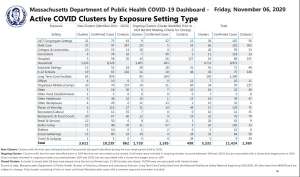BOSTON (WHDH) - The Massachusetts Department of Public Health released an updated list Thursday detailing the number of coronavirus cases in cities and towns across the Commonwealth.
The map was delayed a day while state health officials made changes to the way they assign their color-coded risk levels to cities.
In an attempt to guide schools and businesses through the state’s phased reopening plan, the colors were previously based on an area’s average virus rate out of 100,000 people.
However, many communities across the Bay State do not reach the 100,000 resident threshold.
So, as of Friday, green, yellow, and red designations for moderate- and large-population communities will now be assigned on varying combinations of case rates, total cases, and testing rates rather than just case rates.
Communities with less than 10,000 residents will be categorized as gray if they report less than or equal to 10 coronavirus cases, green if they have 15, yellow for 25, and red for more than 25.
To be classified as red in the middle population range, communities must have either 10 or more cases per 100,000 residents or a positive test rate of 5 percent or higher in the two-week period.
The largest cities and towns with more than 50,000 residents, will only be classified as high risk if they have both 10 cases per 100,000 or more and also a positivity rate of at least 4 percent.
RELATED: Mass. health officials report 2,038 new COVID cases, 21 deaths, 2.4% positivity rate
The statewide average daily case rate is in the yellow zone this week at 15.3 per 100,000 residents with 14,944 new cases reported in the last 14 days.
Just 16 cities and towns now fall in the Department of Public Health’s highest-risk category for COVID-19 transmission under the states new guidelines down from 121 reported last week under the old guidelines. Ninety-one communities are in the yellow, 79 in the green, and 165 are gray.
“Districts and schools in communities designated as gray, green, or yellow are expected to have students learning fully in person if logistically feasible,” Secretary of Education James Peyser said. “Schools in red communities should consider implementing hybrid models instead of going fully remote.”
On Oct. 22, state health officials started designating the coronavirus clusters in locations such as jails, colleges, and nursing homes that have pushed communities into the high-risk zone.
This week no municipalities were given this designation.
The Department of Public Health also began releasing information on the number of cases and contacts associated with clusters of infection in certain settings including households, organized sports, retail settings and social gatherings.
Since last week, 362 more college students have tested positive bringing the total number of cases associated with higher education to 1,945.
Below is a full town-by-town breakdown where data for all 351 communities is included.
[scribd id=483217462 key=key-hFHTUjn2TDtpHWvVZX71 mode=scroll]\
The report states that 101,787 people have completed their quarantine to date and 6,342 are still undergoing theirs.
Click here for more coronavirus coverage.
(Copyright (c) 2024 Sunbeam Television. All Rights Reserved. This material may not be published, broadcast, rewritten, or redistributed.)

